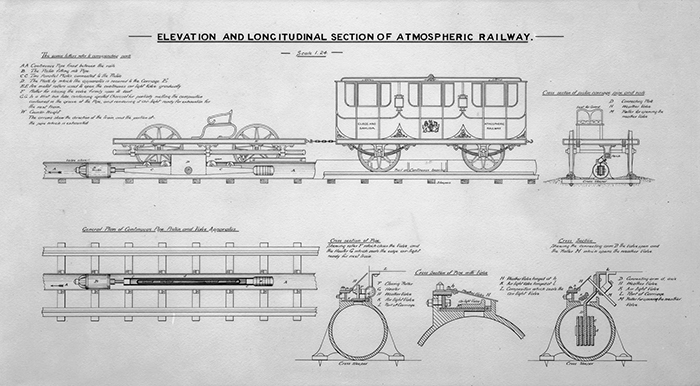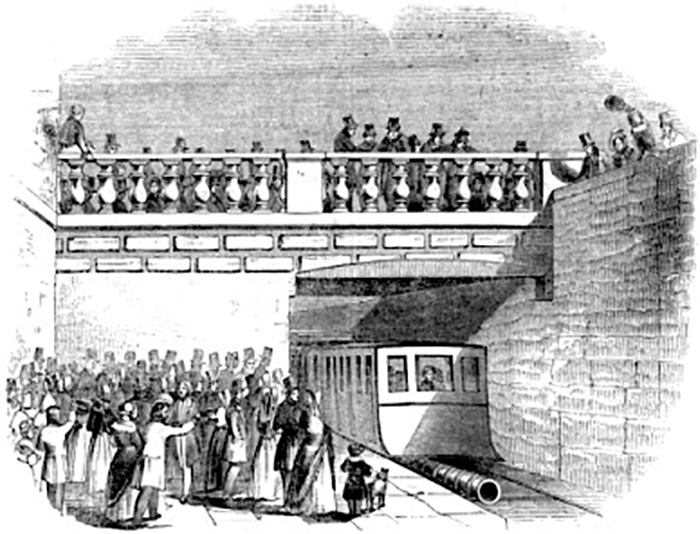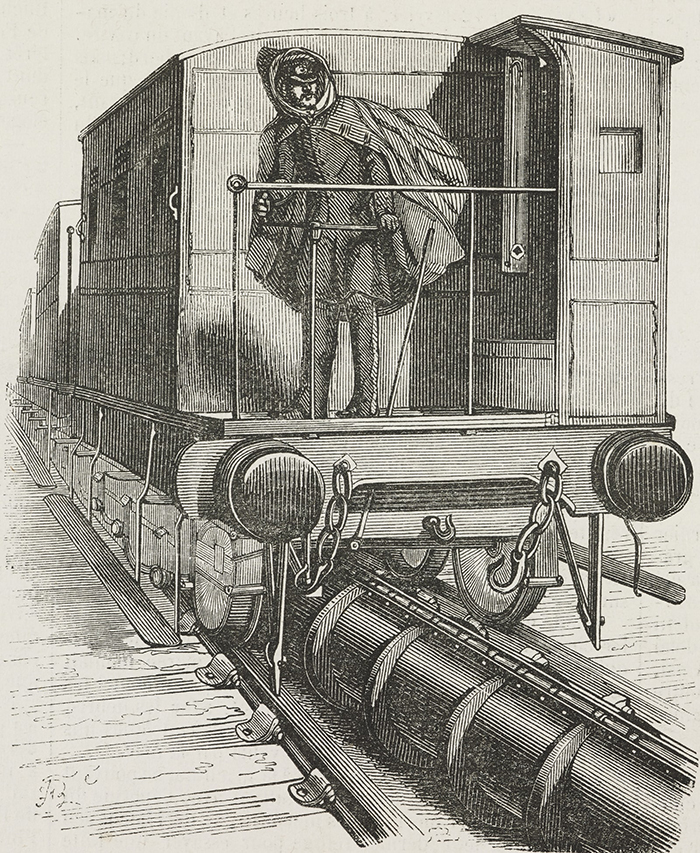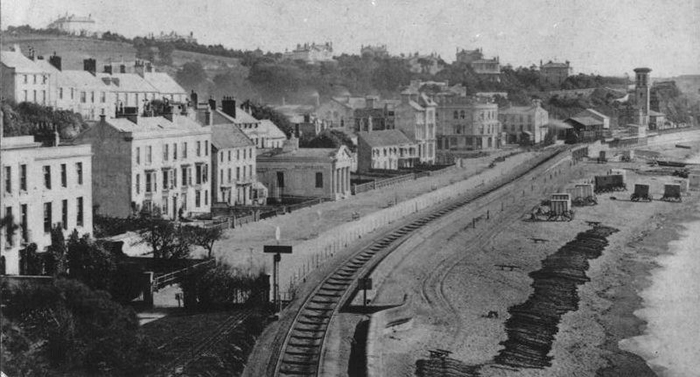

 STUART JORDAN explores the story of this short-lived propulsion system.
STUART JORDAN explores the story of this short-lived propulsion system.
I don't know if it is just the emphasis put on Brunel regarding innovative railway engineering, but I assumed that his South Devon atmospheric railway was the only one around. It seems, however, that there were many that tried to refine the technology before the GWR used it between Exeter and Newton Abbot.
We're getting slightly ahead of ourselves though. For the unaware, an atmospheric railway doesn't use locomotives. Instead, propulsion is provided by air pressure which is transmitted to the train via a piston in a continuous tube between the tracks or, less often, the train itself is sealed within the tube. Varying the air pressure or vacuum via a static pumping station can be used to vary speed and direction, and pressure is maintained by the piston support running through a resealable slot.
The first records of work on an atmospheric railway were proposals by the engineer George Medhurst in the late 18th/early 19th Century. He looked, in detail, into how both methods described above would work, patenting the 'Aeolian' engine which could propel vehicles with compressed air. He didn't patent any of his other ideas, but his work was picked up by others and it influenced the first steps into building a working atmospheric railway.
By 1835 two other engineers, Vallance and Pinkus, had successfully tested their own versions of the atmospheric railway. Neither gained any commercial success, with various limitations holding them back. However, like Medhurst, their work was pioneering and built upon by those who came after. Jacob and Joseph Samuda were brothers who owned a shipbuilding firm in London. They employed a gas engineer named Samuel Clegg, working from Medhurst's own research to develop a system using a small-bore tube. This was patented in 1838 and a couple of years later they leased an unopened stretch of line on the West London Railway for testing.

Samuda's patent plans for their atmospheric railway plans.
Their method worked by laying a continuous cast iron pipe, with a slot in the top, between the rails. The leading car of the train was attached to a piston in the tube, via the slot. The slot was sealed by a flap of leather which maintained air pressure. Rather than pushing the car along with air pressure from a pump, the Samuda/Clegg method worked by pumping the air from the tube ahead of the train. The air pressure from behind the piston would then push it along. Only one pumping station was built, with a 16-horsepower stationary engine, and the gradient on the two-mile test line allowed gravity to be used for the return journey. Under pressure, trains could run at between 20-30 miles per hour.
In 1841 Joseph Samuda published the fifty page 'A Treatise on the Adaptation of Atmospheric Pressure to the Purposes of Locomotion on Railways', outlining the advantages of an atmospheric railway over other methods of propulsion. He argued that the stationary engines used in the pumping stations were more fuel efficient than a locomotive as the train was not having to carry its own power source or fuel. The power available would be greater, allowing steeper gradients to be built upon which would eliminating the need for costly bridges, tunnels, and cuttings. Collisions between trains was impossible as only one train could run in each section at a time, an important factor in this time before modern signalling solutions. Reducing emissions is thought of as a 'modern' idea, but one advantage noted by Samuda was that passengers and residents near the railway would not be subjected to smoke from passing steam engines.
Joseph Samuda did note that if one pumping station failed, the whole line would be blocked. He proposed that a series of pipes would allow the 'dead' line to be powered from another station. His idea was patented in 1844, shortly after his brother Jacob died in a ship explosion. It caught the attention of James Pim, the treasure of the Dublin and Kingstown Railway (D&KR) who was visiting London and saw the test line. The Samuda atmospheric system seemed the perfect solution a problem at the D&KR; how to propel trains up the proposed 1-in-155 gradient extension line from Kingstown to Dalkey. This converted horse tramway was originally used to deliver stone from a quarry to the harbour while it was under construction and the track was steep and heavily curved.

An engraving showing the atmospheric railway arriving at Kingstown on the Dalkey extension.
The Samuda system was installed and the line became the Dalkey Atmospheric Railway, opening in 1844. The 9200ft ascent was powered by vacuum via a 15-inch tube, with the pumping station situated at the top of the line in Dalkey. Trains weighed 38 tons, across seven carriages which could carry a total of two-hundred people. The 100-horsepower single-cylinder stationary steam engine in the pumping station could propel the train at speeds up to forty miles per hour. The journey down was, as in the Samuda test line in London, facilitated by gravity.
The success of the Dalkey line caught the eye of the French minister of public works, M. Teste, and the under-secretary of state, M. Le Grande. They sent one M. Mallet to Dalkey to evaluate it. His findings inspired the building of another extension to an existing the line. In 1837, the Pereire brothers opened the 19km Compagnie du Chemin de fer de Paris à Saint-Germain. The line only ran as far as Le Pecq, as the locomotives of the day could not cope with the steep incline needed if the line went all the way to Saint-Germain. Sound familiar? Much like the Dalkey line, a 1.5km atmospheric line was built up the 1-in-28 gradient, powered by two pumping stations. The train would run back down by gravity as far as Pecq, where a steam engine would then take over for the journey back to Paris.

An evocative image of the Paris-Saint Germain line.
Another visitor to the Dalkey Railway was William Cubit, the engineer for the London and Croydon Railway (L&CR). He thought that the atmospheric system would be ideal to relieve congestion around the 1-in-100 ascent between New Cross and Dartmouth Arms. Slow stopping local services would hold up London and Brighton Railway (L&BR) express trains using the same line. A third line was built for these local services, with a 15-inch traction pipe. South of Norwood Junction the L&CR line had to cross the L&BR and the first railway flyover in the world was built. Ultimately, the atmospheric system was never really a success on the L&CR. Shareholder dissatisfaction with mechanical problems in the pumping stations, coupled with the merger with the L&BR (who were not interested in atmospheric propulsion at all) meant that the after only three years, the line closed in 1847.
By 1844, the Great Western Railway (GWR) had reached Exeter from London. Isambard Kingdom Brunel, approached by local businessmen and politicians, was keen to extend the line southward to Plymouth. The terrain that would have to be traversed was hilly and difficult, with the route also planned to run along the coast past Dawlish to Teignmouth. Brunel had also visited the Dalkey railway (it really was the 'place to be' for 19th Century engineers; Robert Stephenson also went to see it) and was impressed with how effective Samuda's system was at climbing gradients. The route for the South Devon Railway (SDR) line was designed for atmospheric running in mind. The first part of the line opened was the stretch from Exeter to Teignmouth in March 1846, initially using steam locomotives. Atmospheric running was tested the year after, and in August a goods train made up of eleven wagons travelled the 8 ¼ miles from Exeter to Starcross in around fifteen minutes. By January 1847, nearly 900 trains had run on the atmospheric system and by the next year it had been extended to Newton Abbot.

Dawlish, with the tower of the pumping station in the background.
The pumping stations on the SDR were built in the familiar, ornate Italianate style that was prevalent on the GWR and its subsidiaries. Despite the success, however, the line was still running at a loss. The line was also marred with difficulties with the leather flap seals freezing in the winter or drying out in the summer. Brunel had left off the weather seal that was in Samuda’s original plans. In 1847 the L&CR had abandoned their atmospheric line, increasing scepticism amongst Brunel's colleagues at the GWR.
The GWR board of directors instructed him to stop work on the pumping engines to the west of Totnes. At a board meeting in August, it was voted unanimously to suspend the use of the system. Samuda was still contracted to ensure the running of the system, but he was unable to provide any answers, so the last atmospheric train on the SDR arrived at Exeter at 0030 on the morning of Sunday 10th September 1848. Samuda moved away from engineering, becoming a Member of Parliament instead. Both the SDR and the L&CR had invested around half a million pounds on their atmospheric experiments; an enormous amount of money at the time.
The Dalkey Atmospheric Railway stopped atmospheric running in 1854, as did Paris-Saint Germain line in 1860. Improvements in locomotive technology meant that they now had the power to climb steeper inclines, and the use of banking locomotives was introduced on the French line. It seems that ultimately the likes of Samura and Brunel were held back by the technology of their time and could have achieved more if the seal problem could have been overcome.